La Fete Lautomne Article 18 Art Form Fine Collectibles

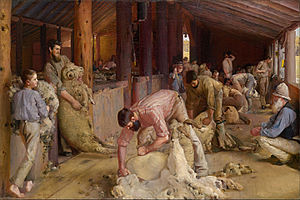
The Heidelberg Schoolhouse was an Australian art move of the belatedly 19th century. It has latterly been described every bit Australian impressionism. [one]
Melbourne fine art critic Sidney Dickinson coined the term in an 1891 review of works by Arthur Streeton and Walter Withers, 2 local artists who painted en plein air in Heidelberg on the city'southward rural outskirts. The term has since evolved to embrace painters who worked together at "artists' camps" around Melbourne and Sydney in the 1880s and 1890s. Forth with Streeton and Withers, Tom Roberts, Charles Conder and Frederick McCubbin are considered key figures of the movement. Drawing on naturalist and impressionist ideas, they sought to capture Australian life, the bush-league, and the harsh sunlight that typifies the country.
The movement emerged at a time of strong nationalist sentiment in Australia, so a grouping of colonies on the cusp of federating. The artists' paintings, not unlike the bush poems of the Bulletin School, were celebrated for being distinctly Australian in character, and by the early 20th century, critics had come to identify the movement every bit the beginning of an Australian tradition in Western art. Many of their well-nigh recognisable works tin can be seen in Australia's major public galleries, including the National Gallery of Australia, the National Gallery of Victoria and the Fine art Gallery of New S Wales.
History [edit]
The name refers to the and so rural area of Heidelberg, e of Melbourne, where practitioners of the way plant their subject matter, though usage expanded to comprehend other Australian artists working in like areas. The cadre grouping painted together at "artists' camps", the first existence the Box Colina artists' camp, established in 1885. Besides Arthur Streeton and Walter Withers, other major artists in the movement included Tom Roberts, Frederick McCubbin and Charles Conder.[two] Run across below for a list of other associated artists.
9 by 5 Impression Exhibition [edit]

The exhibition'south catalogue, designed past Charles Conder
In Baronial 1889, several artists of the Heidelberg School staged the 9 by v Impression Exhibition at Buxton's Rooms, Swanston Street, opposite the Melbourne Town Hall. The exhibition's three principal artists were Charles Conder, Tom Roberts and Arthur Streeton, with modest contributions from Frederick McCubbin, National Gallery students R. E. Falls and Herbert Daly, and sculptor Charles Douglas Richardson, who exhibited five sculpted impressions. Well-nigh of the 183 works included in the exhibition were painted on wooden cigar-box lids, measuring ix by five inches (23 × xiii cm), hence the name of the exhibition. Louis Abrahams, a member of the Box Hill artists' military camp, sourced nigh of the lids from his family's tobacconist shop. In order to emphasise the pocket-sized size of the paintings, the artists displayed them in broad Crimson Gum frames, some left unornamented, others decorated with verse and pocket-size sketches, giving the works an "unconventional, avant garde look".[3] The Japonist décor of Buxton's Rooms featured Japanese screens, umbrellas, and vases with flowers that perfumed the gallery, while the influence of Whistler's Aestheticism also shone through in the harmony and "total effect" of the display.[4]
The artists wrote in the catalogue:
An consequence is but momentary: and then an impressionist tries to detect his identify. 2 one-half-hours are never alike, and he who tries to paint a sunset on two successive evenings, must be more or less painting from memory. So, in these works, it has been the object of the artists to render faithfully, and thus obtain first records of effects widely differing, and oft of very fleeting character.
The exhibition caused a stir with many members of Melbourne'south 'intelligentsia' attending during its three-calendar week run. The general public, though somewhat bemused, responded positively, and within two weeks of the opening, well-nigh of the ix by 5s had sold. The response from critics, however, was mixed. The most scathing review came from James Smith, then Australia's foremost art critic, who said the 9 by 5s were "destitute of all sense of the beautiful" and "whatsoever influence [the exhibition] was likely to exercise could scarcely be otherwise than misleading and pernicious."[5] The artists pasted the review to the entrance of the venue—attracting many more passing pedestrians to, in Streeton's words, "see the dreadful paintings"—and responded with a alphabetic character to the Editor of Smith's newspaper, The Argus. Described equally a manifesto, the letter defends freedom of option in subject and technique, last:
It is meliorate to give our own thought than to get a just superficial issue, which is apt to be a repetition of what others have washed before u.s.a., and may shelter united states of america in a safe mediocrity, which, while information technology volition not attract condemnation, could never assistance towards the evolution of what we believe volition be a nifty school of painting in Australia.[half-dozen]
The 9 past 5 Impression Exhibition is at present regarded every bit a landmark event in Australian fine art history.[7] Approximately i-tertiary of the 9 by 5s are known to have survived, many of which are held in Australia'south public collections, and have sold at auction for prices exceeding $one,000,000.
-

Charles Conder, Centennial Choir at Sorrento, 1889
-

Charles Conder, Going Home, 1889
-

Tom Roberts, Saplings, 1889
-

Tom Roberts, The Violin Lesson, 1889
-

Arthur Streeton, Twilight, E Melbourne, 1889
-

Arthur Streeton, The National Game, 1889
Grosvenor Chambers [edit]


Tom Roberts, An Australian Native, 1888
Built "expressly for occupation by artists" by the fine art decorating firm Paterson Bros. (established by Hugh and James Paterson, brothers of plein airist and associate of the Heidelberg School John Ford Paterson), Grosvenor Chambers opened at the eastern end of Collins Street in April 1888 and rapidly became the focal bespeak of Melbourne'southward art scene, as well as an urban base from which members of the Heidelberg Schoolhouse could receive sitters for portraits. The architects bundled the lighting and interior design of the building after consulting Roberts, who, along with Heidelberg School members Jane Sutherland and Clara Southern, was amid the outset artists to occupy studios in the building. They were soon followed past Conder, Streeton, McCubbin, Louis Abrahams and John Mather, amongst others.[8]
Many of the artists decorated their studios in an Artful manner, showing the influence of James Abbott McNeill Whistler. Roberts' apply of eucalypts and golden wattle as decorations started a fad for Australian flora in the home. He besides initiated in-studio conversaziones at which artists discussed recent artistic trends and read the latest art journals.[eight]
The presence of Roberts, Streeton and Conder at Grosvenor Chambers accounts for the high number of urban views they included in the 9 by 5 Impression Exhibition, including Roberts' By the Treasury, painted from the vantage point of his studio and featuring the Old Treasury Building on Spring Street.[8]
Sydney [edit]
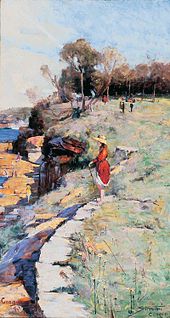
Arthur Streeton, Sunlight Sweet, Coogee, 1890
Roberts kickoff visited Sydney in 1887. At that place, he adult a stiff artistic friendship with Charles Conder, a immature painter who had already gone on plein air excursions outside Sydney and picked upward some impressionist techniques from expatriate artist M. P. Nerli. In early 1888, before Conder joined Roberts on his return trip to Melbourne, the pair painted companion works at the beachside suburb of Coogee.
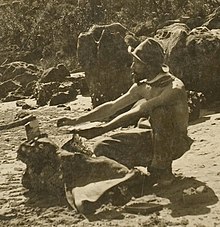
Photograph of Streeton painting en plein air at Curlew Military camp, c. 1892
When a severe economic low hit Melbourne in 1890, Roberts and Streeton moved to Sydney, offset setting upward military camp at Mosman Bay, a minor cove of the harbour, before finally settling effectually the corner at Curlew Camp, which was accessible by the Mosman ferry. Melbourne creative person Albert Henry Fullwood stayed with Streeton at Curlew, as well as other plen air painters on occasion, including prominent art instructor and Heidelberg School supporter Julian Ashton, who resided nearby at the Balmoral artists' camp. Ashton had before introduced Conder to plein air painting, and in 1890, every bit a trustee of the National Gallery of New South Wales in Sydney, secured the acquisition of Streeton's Heidelberg landscape 'Still glides the stream, and shall forever glide' (1890)—the beginning of the artist's works to enter a public collection.[9] The more sympathetic patronage shown by Ashton and others in Sydney inspired more than artists to make the movement from Melbourne.
Streeton won acclaim in Sydney for his harbour views, many of which were collected by Eadith Walker and Howard Hinton, two of the urban center'due south leading art patrons. In a verse form dedicated to the artist, composer and outspoken sensualist George Marshall-Hall alleged Streeton'southward Sydney the "City of laughing loveliness! Sun-girdled Queen!", which became the championship of 1 of his harbour views. The National Gallery of Victoria notes:[ten]
Sydney became Streeton's subject. The bravura of his crisp brushwork and his trademark blue, the bluish that he had used at Heidelberg, were perfectly suited to registering images of the bustling activity on Sydney's blue harbour.
From Sydney, Streeton and Roberts branched out into country New South Wales, where, in the early 1890s, they painted some of their nigh celebrated works.
Influences and manner [edit]
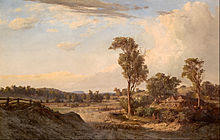
The landscapes of early Melbourne artist Louis Buvelot were particularly influential on the Heidelberg School.
Like many of their contemporaries in Europe and Due north America, members of the Heidelberg School adopted a directly and impressionistic way of painting. They regularly painted landscapes en plein air, and sought to describe daily life. They showed a keen interest in the furnishings of lighting, and experimented with a variety of brushstroke techniques. A number of fine art critics, including Robert Hughes, have noted that the "impressionism" of the Heidelberg School had more in common with Whistler'south tonal impressionism than the broken colours of the French impressionists. Indeed, the Heidelberg School artists did not espouse whatever colour theory, and, unlike the more radical arroyo of the French artists, often maintained some degree of bookish accent on form, clarity and composition.[11] They as well sometimes created works within the narrative conventions of Victorian painting. The Australians had little straight contact with the French impressionists; for example, it was non until 1907 that McCubbin saw their works in person, which encouraged his evolution towards a looser, more bathetic mode.
The Heidelberg School painters were not merely following an international trend, but "were interested in making paintings that looked distinctly Australian".[12] They greatly admired the light-infused landscapes of Louis Buvelot, a Swiss-born artist and fine art instructor who, in the 1860s, adjusted French Barbizon School principles to the countryside effectually Melbourne. Regarding Buvelot as "the male parent of Australian landscape painting", they showed picayune interest in the works of earlier colonial artists, opining that they looked more like European scenes that did non reflect Commonwealth of australia's harsh sunlight, earthier colours and distinctive vegetation. The Heidelberg School painters spoke of seeing Commonwealth of australia "through Australian optics", and by 1889, Roberts argued that they had successfully developed "a distinct and vital and creditable style".[xiii] The notion that they were the first to objectively capture Australia's "scrubby bush" gained widespread acceptance in the early 20th century, merely has since been disputed; for example, art historian Bernard Smith identified "an authentic bush atmosphere" in John Lewin'south landscapes of the 1810s,[xiv] and John Glover in the 1830s is seen to have faithfully rendered Australia's unique low-cal and sprawling, untidy gum trees.[xv]
Associated artists [edit]
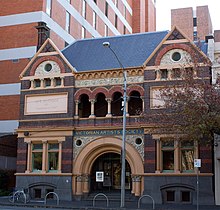
There was no official membership of the Heidelberg School, only artists are said to be office of the movement based on their adoption of plein airism and impressionist techniques, equally well as their attendance at the Melbourne and Sydney "artists' camps". Heidelberg School artists also oft trained together at the National Gallery of Victoria Art School, and staged group exhibitions at the Victorian Artists' Club. Fine art historians have included the following people in the movement:[two]
- Louis Abrahams
- Julian Ashton
- Charles Conder
- David Davies
- Emanuel Phillips Fox
- Ethel Carrick Play a joke on
- Albert Henry Fullwood
- Ina Gregory
- Tom Humphrey
- John Llewellyn Jones
- John Mather
- Frederick McCubbin
- Leon Pole
- Jane Cost
- Charles Douglas Richardson
- Tom Roberts
- Arthur Streeton
- Clara Southern
- Jane Sutherland
- Tudor St. George Tucker
- Walter Withers
Locations [edit]
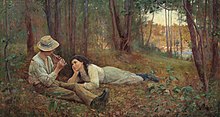

- Heidelberg
- Beaumaris
- Blackburn
- Box Hill (see Box Hill artists' camp)
- Bulleen
- Templestowe
- Warrandyte
- Eltham
- Research
- Diamond Creek
- Ferntree Gully
- Kallista
- Olinda
- Mount Dandenong
- Kalorama
- Silvan
- Lilydale
- Yarra Glen
- Coldstream
- Yering
- Mentone
- Sydney artists' camps
Legacy [edit]

One of the many signs forth the Heidelberg Artists Trail, marking the approximate location where a particular painting was created
Writing in 1980, Australian artist and scholar Ian Burn described the Heidelberg Schoolhouse every bit "mediating the relation to the bush of most people growing up in Australia. ... Mayhap no other local imagery is so much a part of an Australian consciousness and ideological make-upward."[16] Their works are known to many Australians through reproductions, appearing in bars and motels, on stamps and every bit the covers of paperback copies of colonial literature. Heidelberg School artworks are among the most collectible in Australian art; in 1995, the National Gallery of Australia acquired Streeton's Golden Summer, Eaglemont (1889) from a private owner for $3.v million, then a record price for an Australian painting.[17] McCubbin'south Bush Idyll (1893) briefly held the record price for a publicly auctioned Australian painting when it sold at Christie's in 1998 for $2.31 meg.[18]
Many menstruation films of the Australian New Moving ridge drew upon the visual style and field of study matter of the Heidelberg Schoolhouse.[19] For Picnic at Hanging Rock (1975), director Peter Weir studied the Heidelberg Schoolhouse equally a basis for art direction, lighting, and composition.[xx] Sunday Too Far Away (1975), set on an outback sheep station, pays homage to Roberts' shearing works, to the extent that Shearing the Rams is recreated within the film. When shooting the landscape in The Chant of Jimmie Blacksmith (1978), cinematographer Ian Baker tried to "make every shot a Tom Roberts".[21] The Getting of Wisdom (1977) and My Brilliant Career (1979) each found inspiration in the Heidelberg School;[xix] outback scenes in the latter allude direct to works by Streeton, such as The Selector'southward Hut.[22]
The Heidelberg School is examined in I Summer Over again, a iii-function docudrama that first aired on ABC television in 1985.
The movement featured in the Australian citizenship test, overseen past former prime number minister John Howard in 2007. Such references to history were removed the post-obit year, instead focusing on "the commitments in the pledge rather than being a full general noesis quiz nigh Commonwealth of australia."[23]
The movement has been surveyed in major exhibitions, including the nationwide blockbuster Aureate Summers: Heidelberg and Beyond (1986), and Australian Impressionism (2007), held at the National Gallery of Victoria.[24] Inspired by their acquisition of Streeton's 1890 painting Blue Pacific, the National Gallery in London hosted an exhibition titled Commonwealth of australia'due south Impressionists between December 2016 and March 2017, focusing on works by Streeton, Roberts, Conder and John Russell, an Australian impressionist based in Europe.[25] In 2021, from April to August, the National Gallery of Victoria will host the exhibition She-Oak and Sunlight: Australian Impressionism.[26]
Gallery [edit]
-

Jane Sutherland, Obstacle, Box Colina, 1887
-

John Mather, The Artist (Louis Abrahams) at His Easel, 1887
-

Julian Ashton, The Corner of the Paddock, 1888
-

Leon Pole, The Village Laundress, 1891
-
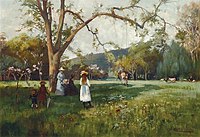
Albert Henry Fullwood, The Swing, 1892
-

David Davies, Moonrise, 1893
-
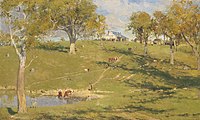
Walter Withers, Tranquil Winter, 1894
-

Emmanuel Phillips Pull a fast one on, Art Students, 1895
See besides [edit]
- John Russell, Australian impressionist who spent much of his career in France
- Iso Rae, Australian impressionist who spent much of her career in French republic
General:
- Visual arts of Australia
- Impressionism
References [edit]
- ^ "Introduction to Australian Impressionism". Australian Impressionism. Melbourne: National Gallery of Victoria. Retrieved viii April 2010.
- ^ a b Heidelberg Artists Trail
- ^ Lane, Australian Impressionism, p. 159
- ^ Clark 1986, p. 114.
- ^ Smith, James. "An Impressionist Exhibition". The Argus. 17 August 1889.
- ^ Conder, Charles; Roberts, Tom; Streeton, Arthur. "Concerning 'Impressions' in Painting". The Argus. 3 September 1889.
- ^ Moore, William (1934). The Story of Australian Art. Sydney: Angus & Robertson. ISBN 0-207-14284-X. p. 74
- ^ a b c Significant sites, National Gallery of Victoria. Retrieved 29 February 2016.
- ^ Galbally, Ann (1972). Arthur Streeton. Oxford University Press, p. thirteen.
- ^ Australian Impressionism: Sites, National Gallery of Victoria. Retrieved 16 March 2016.
- ^ Hughes, Robert (1966). The Fine art of Australia. Penguin Books Australia Ltd, Melbourne. ISBN 0 14 0 20935 2. pp. 55-56.
- ^ Australian Impressionism: Education Resource, National Gallery of Victoria. Retrieved 16 March 2016.
- ^ "An Australian Artist: A Fiddling Talk With Tom Roberts", Melbourne Punch. Retrieved 4 May 2020.
- ^ Smith, Bernard (1962). Australian Painting: 1788-1960. Oxford University Printing, p. 19.
- ^ McPhee, John (2003). The Art of John Glover.
- ^ Burn, Ian. "Beating Virtually the Bush-league: The Landscapes of the Heidelberg School". In Bradley, Anthony; Smith, Terry. Australian Art and Architecture. Oxford University Printing, 1980. ISBN 0195505883, pp. 83–98
- ^ Strickland, Katrina. Affairs of the Fine art: Love, Loss and Power in the Art World. Melbourne University Publishing, 2013. ISBN 9780522864083.
- ^ Rule, Andrew (3 October 2013). "Fifteen years after setting a sales record, a famous painting fails to sell", Herald Sun. Retrieved 5 December 2018.
- ^ a b Gray, Anne (ed.) Australian Art in the National Gallery of Australia. Canberra: National Gallery of Australia, 2002. ISBN 0642541426, p. 12
- ^ Rayner, Jonathan. The Films of Peter Weir. London: Continuum International Publishing Group, 2003. ISBN 0826419089, pp. 70–71
- ^ Reynolds, Henry. The Chant of Jimmie Blacksmith. Sydney: Currency Press, 2008. ISBN 0868198242, p. 66
- ^ Elliot, Bonnie. "My Brilliant Career", World Cinema Directory. Retrieved xvi March 2013.
- ^ Anderson, Laura (22 November 2008). "Sporting focus taken off citizenship exam", Herald Sunday. Retrieved 13 March 2013.
- ^ Grishin, Sasha (23 March 2016). "Tom Roberts at the National Gallery of Australia has gone gangbusters and here'south why", Canberra Times. Retrieved 27 March 2016.
- ^ Collings, Matthew (6 December 2016). "Australia'south Impressionists, exhibition review: A fascinating show on an explosive theme", Standard. Retrieved 18 May 2017.
- ^ Grishin, Sasha (7 April 2021). "She-Oak and sunlight: 'the best feelgood bear witness I take seen since COVID'", Chat. Retrieved 13 April 2021.
Further reading [edit]
- Astbury, Leigh (1985). City Bushmen: The Heidelberg School and the Rural Mythology. Oxford University Printing. ISBN0-xix-554501-Ten.
- Astbury, Leigh (1989). Sunlight and Shadow: Australian Impressionist Painters 1880-1900. Bay Books. ISBN1862562954.
- Caulfield, North (1988). The Australian Impressionists: Their Origins and Influences. Lauraine Diggins Fine Arts. ISBN0959274340.
- Clark, Jane; Whitelaw, Bridget (1985). Golden Summers: Heidelberg and Beyond. International Cultural Corporation of Australia. ISBN0642081824.
- Finlay, Eleanor; Morgan, Marjorie Jean (2007). Prelude to Heidelberg: The Artists' Camp at Box Hill. MM Publishing/Metropolis of Whitehorse. ISBN0646484125.
- Gleeson, James (1976). Impressionist Painters, 1881-1930. Lansdowne Publishing. ISBN0-7018-0990-6.
- Hammond, Victoria; Peers, Juliette (1992). Completing the Picture: Women Artists and the Heidelberg Era. Artmoves. ISBN0-6460-7493-8.
- Lane, Terence (2007). Australian Impressionism. National Gallery of Victoria. ISBN0-7241-0281-7.
- McCulloch, Alan (1977). The Golden Age of Australian Painting: Impressionism and the Heidelberg School. Lansdowne Publishing. ISBN0-7018-0307-X.
- Splatt, William (1989). The Heidelberg Schoolhouse: The Golden Summer of Australian Painting. Viking O'Neil. ISBN0-670-90061-3.
- Topliss, Helen (1984). The Artists' Camps: Plein Air Painting in Melbourne 1885-1898. Monash University Gallery. ISBN0-8674-6326-0.
External resources [edit]
- In the Artist'due south Footsteps
- Heidelberg School - The Encyclopedia of Melbourne Online
- National Gallery of Victoria: Australian Impressionism Teaching Resource
Source: https://en.wikipedia.org/wiki/Heidelberg_School
0 Response to "La Fete Lautomne Article 18 Art Form Fine Collectibles"
Post a Comment